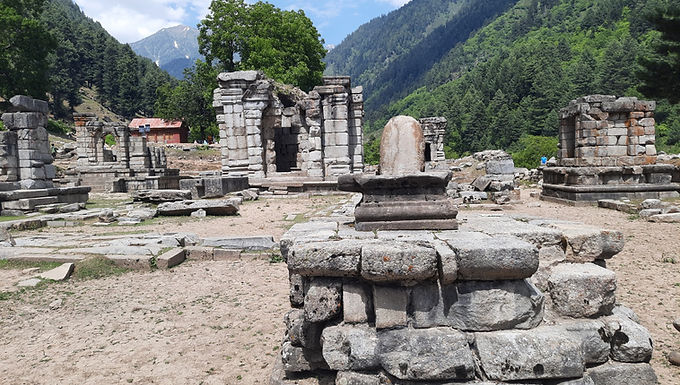Naranag Temple

The Naranag Temple Complex, nestled in the serene village of Wangath in the Ganderbal district of Jammu and Kashmir, is an ancient site steeped in history, spirituality, and architectural grandeur. Believed to date back to 220 BCE, the temple complex is associated with Lord Shiva and is mentioned in historical texts such as Rajatarangini by Kalhana and the Nilamata Purana, which highlight its sanctity and importance in Kashmiri culture and religion.
Historical Significance
The Naranag temples were primarily built to honor Lord Shiva and his forms, including Bhuteshwara, Jyeshtharudra, and Jaluka. King Lalitaditya Muktapida of the 8th century CE is credited with patronizing and expanding the temple complex, which also served as an important pilgrimage site. According to legends, Sage Vashishta consecrated one of the shrines, making the area sacred. Pilgrims historically visited the temples after completing their trek to Gangabal Lake, which was a major site for performing last rites and immersing ashes.
The temples also played a role as a treasury and were integral to the region's governance during ancient times. Historical records suggest that King Lalitaditya borrowed funds from the Bhuteshwara temple treasury during his military campaigns and repaid them manifold after his victories.
Temple Architecture
The Naranag complex comprises three main groups of temples, built in different periods, reflecting varied architectural styles. The temples are constructed from locally sourced kanjur stone and granite, showcasing meticulous craftsmanship.
Main Temple: Identified as the Shiva-Jyeshtharudra temple, this structure features a domed ceiling with a lotus-shaped apex and entrances on the northeast and southwest sides.
Secondary Temples: Smaller shrines with simple designs, domed ceilings, and rectangular pedestals for idols are located nearby.
Baradari (Congregation Hall): Ruins of a large pillared hall suggest its use for assemblies and rituals.
The temples are surrounded by remnants of boundary walls, gateways, and a long granite causeway, indicating the scale and significance of the complex.
Natural Springs and Scenic Location
The name "Naranag" derives from the numerous natural springs found around the temple site. These springs, believed to possess sacred properties, add to the spiritual allure of the location. The complex is set against the backdrop of the majestic Harmukh Mountains, with dense pine and fir forests surrounding it. The nearby Sindh River flows torrentially, creating a tranquil contrast to the silence of the forest. This picturesque environment enhances the divine atmosphere of the site.
Present Condition
Sadly, the Naranag temples have suffered centuries of neglect, natural decay, and human vandalism. Most structures are in ruins, with only remnants of walls, domes, and pedestals standing. Moss and vegetation have overgrown the site, and graffiti marks some of the remaining carvings. The absence of systematic preservation efforts has left this historical gem vulnerable to further degradation.
Locals often visit the site as a picnic spot, and the lack of visitor management has contributed to littering and disrespectful behavior, undermining its historical significance.
The Naranag Temple Complex is a remarkable relic of Kashmir's spiritual and architectural heritage. Immediate conservation and awareness efforts are needed to preserve this treasure for future generations. With its historical significance, architectural beauty, and breathtaking location, Naranag remains a symbol of Kashmir's rich cultural past.
